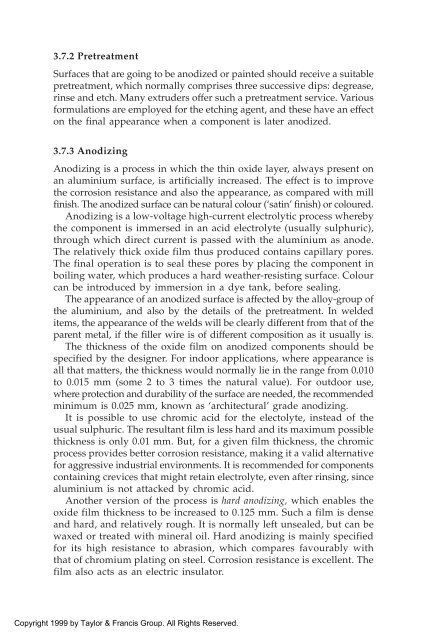Aluminium Design and Construction John Dwight
Aluminium Design and Construction John Dwight
Aluminium Design and Construction John Dwight
Create successful ePaper yourself
Turn your PDF publications into a flip-book with our unique Google optimized e-Paper software.
3.7.2 Pretreatment<br />
Surfaces that are going to be anodized or painted should receive a suitable<br />
pretreatment, which normally comprises three successive dips: degrease,<br />
rinse <strong>and</strong> etch. Many extruders offer such a pretreatment service. Various<br />
formulations are employed for the etching agent, <strong>and</strong> these have an effect<br />
on the final appearance when a component is later anodized.<br />
3.7.3 Anodizing<br />
Anodizing is a process in which the thin oxide layer, always present on<br />
an aluminium surface, is artificially increased. The effect is to improve<br />
the corrosion resistance <strong>and</strong> also the appearance, as compared with mill<br />
finish. The anodized surface can be natural colour (‘satin’ finish) or coloured.<br />
Anodizing is a low-voltage high-current electrolytic process whereby<br />
the component is immersed in an acid electrolyte (usually sulphuric),<br />
through which direct current is passed with the aluminium as anode.<br />
The relatively thick oxide film thus produced contains capillary pores.<br />
The final operation is to seal these pores by placing the component in<br />
boiling water, which produces a hard weather-resisting surface. Colour<br />
can be introduced by immersion in a dye tank, before sealing.<br />
The appearance of an anodized surface is affected by the alloy-group of<br />
the aluminium, <strong>and</strong> also by the details of the pretreatment. In welded<br />
items, the appearance of the welds will be clearly different from that of the<br />
parent metal, if the filler wire is of different composition as it usually is.<br />
The thickness of the oxide film on anodized components should be<br />
specified by the designer. For indoor applications, where appearance is<br />
all that matters, the thickness would normally lie in the range from 0.010<br />
to 0.015 mm (some 2 to 3 times the natural value). For outdoor use,<br />
where protection <strong>and</strong> durability of the surface are needed, the recommended<br />
minimum is 0.025 mm, known as ‘architectural’ grade anodizing.<br />
It is possible to use chromic acid for the electolyte, instead of the<br />
usual sulphuric. The resultant film is less hard <strong>and</strong> its maximum possible<br />
thickness is only 0.01 mm. But, for a given film thickness, the chromic<br />
process provides better corrosion resistance, making it a valid alternative<br />
for aggressive industrial environments. It is recommended for components<br />
containing crevices that might retain electrolyte, even after rinsing, since<br />
aluminium is not attacked by chromic acid.<br />
Another version of the process is hard anodizing, which enables the<br />
oxide film thickness to be increased to 0.125 mm. Such a film is dense<br />
<strong>and</strong> hard, <strong>and</strong> relatively rough. It is normally left unsealed, but can be<br />
waxed or treated with mineral oil. Hard anodizing is mainly specified<br />
for its high resistance to abrasion, which compares favourably with<br />
that of chromium plating on steel. Corrosion resistance is excellent. The<br />
film also acts as an electric insulator.<br />
Copyright 1999 by Taylor & Francis Group. All Rights Reserved.















